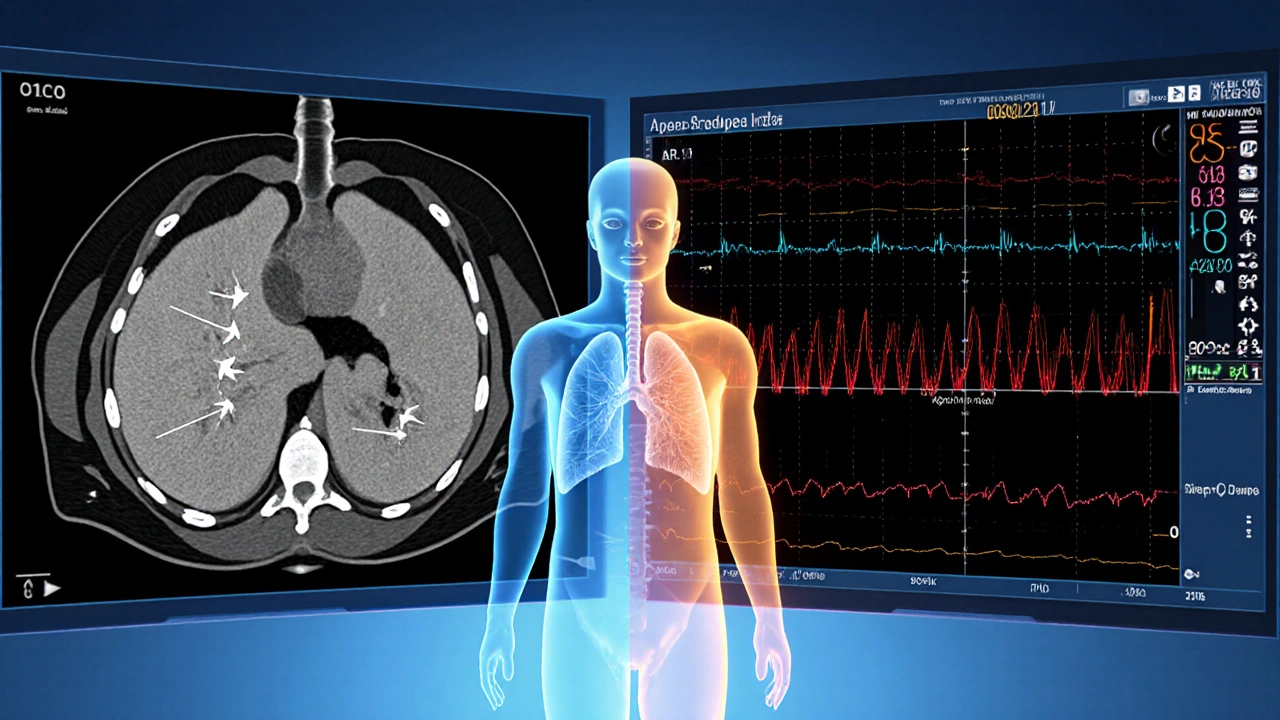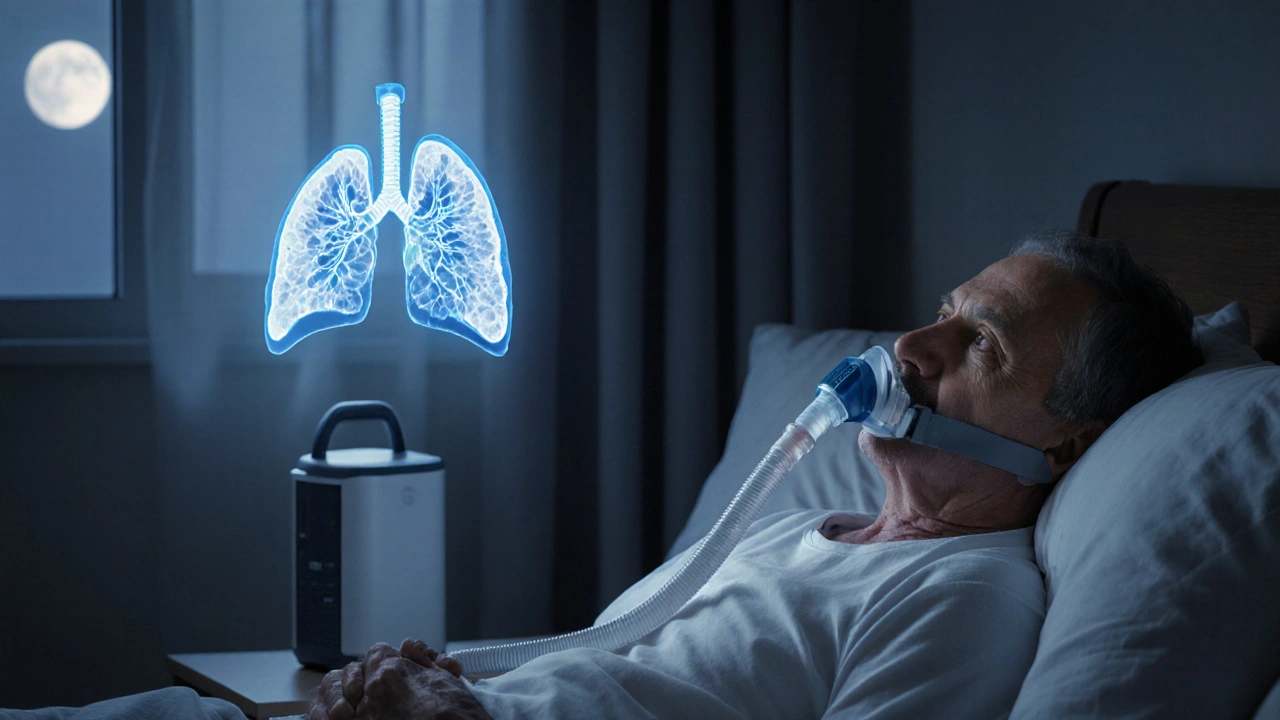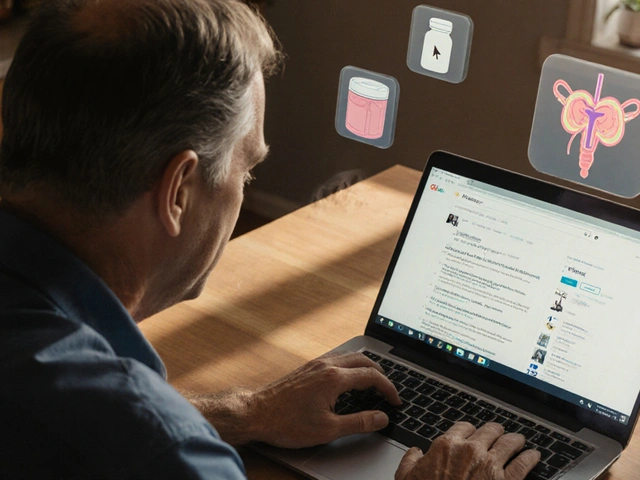Sleep Apnea Severity Calculator
This tool estimates your sleep apnea severity based on symptoms and risk factors. Remember that this is for informational purposes only and not a substitute for professional medical evaluation.
Assess Your Symptoms
Imagine trying to catch your breath while you sleep and waking up feeling as if you’ve run a marathon. For many living with both idiopathic pulmonary fibrosis (IPF) and obstructive sleep apnea (OSA), this isn’t imagination-it’s daily reality. This guide pulls apart the science, the symptoms, and the practical steps you can take to keep both conditions from hijacking your life.
What Is Idiopathic Pulmonary Fibrosis?
Idiopathic Pulmonary Fibrosis is a chronic lung disease where scar tissue forms in the walls of the tiny air sacs, known as alveoli. This scarring, or fibrosis, stiffens the lungs and makes oxygen transfer difficult. The cause is unknown-hence "idiopathic"-but risk factors include age over 60, smoking history, and genetic predisposition. Typical symptoms are a dry cough, progressive shortness of breath, and fatigue.
According to the Global Lung Initiative, about 13,000 new cases are diagnosed yearly in the UK, and the average survival after diagnosis hovers around three to five years without treatment.
Understanding Sleep Apnea
Obstructive Sleep Apnea is a sleep‑related breathing disorder where the airway collapses repeatedly during sleep, causing brief pauses in breathing. The most common form, OSA, triggers snoring, gasping, and daytime sleepiness. Risk factors overlap with IPF-age, smoking, and obesity-making the pair a frequent double‑hit.
Polysomnography, a night‑time sleep study, measures the apnea‑hypopnea index (AHI). An AHI of 15 or higher typically confirms moderate to severe OSA.

Why They Often Appear Together
Two main mechanisms link IPF and OSA:
- Reduced lung compliance. As fibrosis stiffens the lung, the chest wall works harder to expand, increasing negative pressure in the airway during inhalation-this pressure can promote airway collapse.
- Chronic hypoxia. Low oxygen levels from IPF stimulate the body’s chemoreceptors, which can alter breathing patterns during sleep, making apneas more likely.
Studies from the European Respiratory Journal in 2023 found that up to 45% of IPF patients also meet criteria for moderate‑to‑severe OSA, a rate far higher than in the general population.
Diagnosing Both Conditions
Early detection hinges on a combination of clinical clues and tests.
- Medical history review - look for progressive dyspnea, chronic cough, loud snoring, and witnessed pauses.
- Physical exam - check for clubbing of fingers (a sign of chronic hypoxia) and enlarged neck circumference.
- Pulmonary Function Test - typically shows a restrictive pattern in IPF (reduced forced vital capacity) while lung volumes may be normal in OSA.
- High‑Resolution CT Scan - reveals usual interstitial pneumonia pattern for IPF (honey‑comb lung).
- Polysomnography - confirms OSA severity.
Because symptoms overlap, clinicians often order both a HRCT and a sleep study when a patient with IPF reports daytime fatigue or loud snoring.
Treatment Options When They Co‑Exist
Managing one condition without addressing the other can limit benefits. Here’s how the two are tackled together:
- Antifibrotic therapy. Medications like Pirfenidone and Nintedanib slow scar formation. They don’t cure IPF but can extend survival by 4-6 months on average.
- Continuous Positive Airway Pressure (CPAP). A CPAP machine delivers steady air pressure, keeping the airway open. For IPF patients, CPAP also improves nighttime oxygenation, reducing the extra work the heart must do.
- Oxygen therapy. Supplemental oxygen, prescribed based on resting or exercise‑induced desaturation, alleviates breathlessness and can lower the severity of sleep‑related hypoxia.
- Lung transplant evaluation. For advanced IPF, transplant remains the only curative option. Candidates must have OSA well‑controlled-often with CPAP-before surgery.
Lifestyle tweaks bolster medical treatment:
- Quit smoking - the single most impactful change.
- Maintain a healthy weight - reduces OSA pressure on the airway.
- Engage in low‑impact exercise - improves lung capacity and sleep quality.
- Adopt a regular sleep schedule - helps stabilize breathing patterns.

Living With IPF and Sleep Apnea
Day‑to‑day management blends monitoring, medication adherence, and support.
- Regular follow‑up. Pulmonologists typically schedule HRCT and lung function tests every 3-6 months. Sleep specialists may adjust CPAP pressures annually.
- Symptom diary. Logging cough frequency, oxygen saturation (via pulse oximeter), and CPAP usage highlights trends and alerts doctors to worsening disease.
- Vaccinations. Flu and COVID‑19 shots reduce the risk of respiratory infections that can trigger rapid IPF decline.
- Support networks. Groups such as the UK IPF Foundation and Sleep Apnea UK offer peer advice, coping strategies, and latest research updates.
When breathlessness spikes at night, check your CPAP mask for leaks, ensure the humidifier isn’t clogged, and verify that your oxygen flow rate matches the prescription. Small fixes often prevent full‑night desaturation events.
Key Takeaways Checklist
- IPF causes irreversible lung scarring; OSA causes airway blockage during sleep.
- Both conditions share risk factors like age, smoking, and obesity.
- Up to half of IPF patients also have moderate‑to‑severe OSA.
- Diagnosis requires HRCT for IPF and polysomnography for OSA.
- Treatment combines antifibrotics, CPAP, supplemental oxygen, and lifestyle changes.
- Regular monitoring and a symptom diary improve outcomes.
| Feature | Idiopathic Pulmonary Fibrosis | Obstructive Sleep Apnea |
|---|---|---|
| Primary organ affected | Alveolar tissue (lungs) | Upper airway |
| Typical onset | 60‑80 years | 30‑60 years (often earlier if obese) |
| Key symptom | Progressive dyspnea, dry cough | Loud snoring, witnessed apneas |
| Diagnostic test | High‑resolution CT (honey‑comb pattern) | Polysomnography (AHI ≥15) |
| Main treatment | Antifibrotics, oxygen therapy | CPAP, weight management |
| Prognosis | Median survival 3‑5 years without transplant | Effective CPAP can normalize life expectancy |
Idiopathic Pulmonary Fibrosis and sleep apnea may feel like a double burden, but a coordinated care plan can keep you breathing easier day and night.
Frequently Asked Questions
Can CPAP worsen lung fibrosis?
No. CPAP maintains airway patency, improves nighttime oxygen levels, and reduces stress on the heart. It does not accelerate scarring in the lungs.
Is it safe to travel by plane with IPF and OSA?
Yes, provided you have a portable oxygen concentrator approved for in‑flight use and bring your CPAP (or a travel‑compatible device). Notify the airline in advance.
Do antifibrotic drugs affect sleep quality?
Side effects can include nausea and mild insomnia, but these are manageable with timing doses earlier in the evening and using anti‑nausea strategies.
How often should I get my lung function tested?
Every 3-6 months is typical for stable disease; more frequent testing may be needed after a medication change or if symptoms worsen.
Is weight loss enough to cure OSA in IPF patients?
Weight loss improves airway pressure and can lower AHI, but most patients still need CPAP because the underlying lung stiffness in IPF continues to affect breathing dynamics.







Kevin Zac
October 12, 2025 AT 14:15First off, the pathophysiology linking idiopathic pulmonary fibrosis (IPF) and obstructive sleep apnea (OSA) hinges on compromised pulmonary compliance and chemoreceptor dysregulation. When fibrotic remodeling stiffens the alveolar interstitium, inspiratory pressure swings intensify, predisposing to upper‑airway collapse during sleep. Concurrently, chronic hypoxemia augments peripheral chemoreceptor drive, destabilizing ventilatory control loops. This bi‑directional interaction translates into a vicious cycle: nocturnal desaturation worsens fibroproliferative signaling, while progressive fibrosis magnifies the mechanical load on the pharyngeal airway. Epidemiologic data from the European Respiratory Journal indicate a prevalence of up to 45 % for moderate‑to‑severe OSA in the IPF cohort, a figure that eclipses rates in age‑matched controls. From a diagnostic standpoint, clinicians should pursue high‑resolution computed tomography (HRCT) for IPF confirmation and polysomnography for OSA quantification, ideally in a coordinated work‑up. Antifibrotic agents such as pirfenidone and nintedanib attenuate collagen deposition but do not rectify nocturnal airway patency; thus, CPAP remains indispensable for mitigating OSA‑related hypoxic burden. Moreover, supplemental oxygen therapy, titrated to maintain SpO₂ > 90 % during exertion and sleep, can synergize with CPAP to improve nocturnal gas exchange. Patient education is paramount – smoking cessation, weight management, and adherence to CPAP hygiene protocols (mask fit, humidifier maintenance) can yield measurable reductions in apnea‑hypopnea index (AHI) and dyspnea scores. Regular follow‑up intervals (pulmonary function tests every 3‑6 months, sleep study reassessment annually) facilitate early detection of disease progression and therapy optimization. Finally, multidisciplinary collaboration among pulmonologists, sleep specialists, and physiotherapists enhances holistic care, ensuring that both fibrotic and obstructive components are addressed simultaneously.
Stephanie Pineda
October 12, 2025 AT 14:16Wow, reading this feels like diving into a medical encyclopedia that suddenly sprouted a garden of practical tips. The way the guide blends the gritty science of fibrosis with the day‑to‑day hacks – like checking CPAP leaks before bed – is both comforting and empowering. I love the checklist vibe; it turns a daunting regimen into bite‑size actions that don’t feel overwhelming. And those colorful analogies, like “breathing feels like a marathon,” really drive the point home without sounding clinical. Kudos for making such a heavy topic feel approachable.
Anne Snyder
October 12, 2025 AT 14:18Super helpful rundown on why IPF and OSA often travel together. The explanation about negative intrathoracic pressure pushing on the airway made sense after I read it a couple of times. I also appreciated the practical reminder to keep the CPAP humidifier clean – that’s something I keep forgetting. The lifestyle section feels realistic; losing weight when you’re already short of breath is tough, but the guide frames it as a supportive step rather than a burden.
Rebecca M
October 12, 2025 AT 14:20Okay, first – the article is thorough; second – the formatting could use a bit more consistency!!! The bullet points are clear, yet the nested lists sometimes lack proper punctuation…; however, overall the content is spot‑on. I especially like the emphasis on regular follow‑ups and symptom diaries – those are gold standards in chronic disease management. Also, the mention of vaccinations is crucial – flu shots can literally save lives in this population!!!
Bianca Fernández Rodríguez
October 12, 2025 AT 14:21i guess its ok but dont think the author knows how hard it is to stick to CPAP when u cant breathe . also woud be nice if they mentioned cheaper alternatives bc not evryone can afford high‐end machines . lets face it the healthcare system is rigged
Samson Tobias
October 12, 2025 AT 14:23Thank you for highlighting the importance of a coordinated care plan. From my experience, patients who schedule joint appointments with their pulmonologist and sleep specialist tend to have better adherence to both antifibrotic therapy and CPAP. It also reduces the anxiety that comes from juggling multiple providers. Keep reinforcing the value of symptom diaries; they’re indispensable for tracking subtle changes over time.
Alan Larkin
October 12, 2025 AT 14:25Interesting read! 🤓 Just a quick note – the CPAP pressure settings often need tweaking after a few weeks as the patient loses weight or the lung mechanics improve. Also, don’t forget to check the mask seal after a night of heavy coughing; leaks can sabotage the whole therapy. Cheers for the clear tables!
John Chapman
October 12, 2025 AT 14:26While the article is commendably exhaustive, one must recognize the subtle nuances of antifibrotic pharmacodynamics that are glossed over. Pirfenidone’s impact on nocturnal cytokine profiles, for instance, warrants deeper exploration. Moreover, the interplay between CPAP‑induced hyperinflation and alveolar stretch receptors is a frontier ripe for investigation. Such granularity would elevate the guide from a practical handbook to a scholarly reference.
Tiarna Mitchell-Heath
October 12, 2025 AT 14:28Listen, the whole “just use CPAP” line is naive. Most patients can’t even afford the machine, let alone the consumables. The guide should have mentioned community health programs or insurance hacks. And the advice about traveling with a portable oxygen concentrator is outdated – many airlines still refuse without hefty paperwork. Wake up!
Katie Jenkins
October 12, 2025 AT 14:30Great points on regular monitoring, but let’s not forget the importance of proper spirometry technique. Many clinics fail to calibrate their devices, leading to inaccurate FVC readings that can misguide treatment decisions. Also, be wary of over‑reliance on the AHI alone; the desaturation index often provides a more nuanced picture of sleep‑related hypoxia, especially in IPF patients where baseline oxygenation is already compromised.
Jack Marsh
October 12, 2025 AT 14:31Exactly, that's how it goes.
Terry Lim
October 12, 2025 AT 14:33Honestly, the guide oversimplifies adherence. Most patients balk at daily CPAP use, citing discomfort and claustrophobia – no amount of friendly reminders will fix that. A stricter protocol, perhaps with behavioral therapy, would be more realistic than vague encouragement.
Cayla Orahood
October 12, 2025 AT 14:35What they don’t tell you is that the medical establishment is silently pushing these “CPAP machines” as a way to keep us hooked on endless equipment sales. The real hidden agenda? Data collection on sleep patterns to fuel big‑tech algorithms. Stay vigilant, question the source, and consider alternative breathing techniques that aren’t patented.
McKenna Baldock
October 12, 2025 AT 14:36Reflecting on the interplay of fibrosis and sleep‑disordered breathing invites a broader philosophical inquiry: how do we reconcile the deterministic nature of cellular pathology with the agency of lifestyle modifications? While the guide provides pragmatic steps, it also subtly reminds us that even in the face of inexorable scarring, human choice-weight management, adherence to CPAP-remains a vital, albeit limited, counterforce.
Roger Wing
October 12, 2025 AT 14:38This guide is just another piece of the pharma‑driven narrative. They mention antifibrotics as life‑extending miracles, yet ignore the massive side‑effect burden and the fact that most patients never get access due to insurance hurdles. And the CPAP spiel? Purely profit‑driven, not patient‑centric. Wake up.
Matt Cress
October 12, 2025 AT 14:40Oh great, another “one‑size‑fits‑all” recommendation. As if a UK‑centric sleep clinic protocol magically applies to every corner of the globe. Cultural dietary habits, housing ventilation, even the prevalence of night‑shifts can drastically alter OSA presentation. A little humility would go a long way.
Andy Williams
October 12, 2025 AT 14:41While the checklist is useful, it could benefit from a stronger emphasis on the quantitative thresholds that define treatment escalation – for instance, specifying the exact SpO₂ cut‑offs that trigger supplemental oxygen versus CPAP titration adjustments.